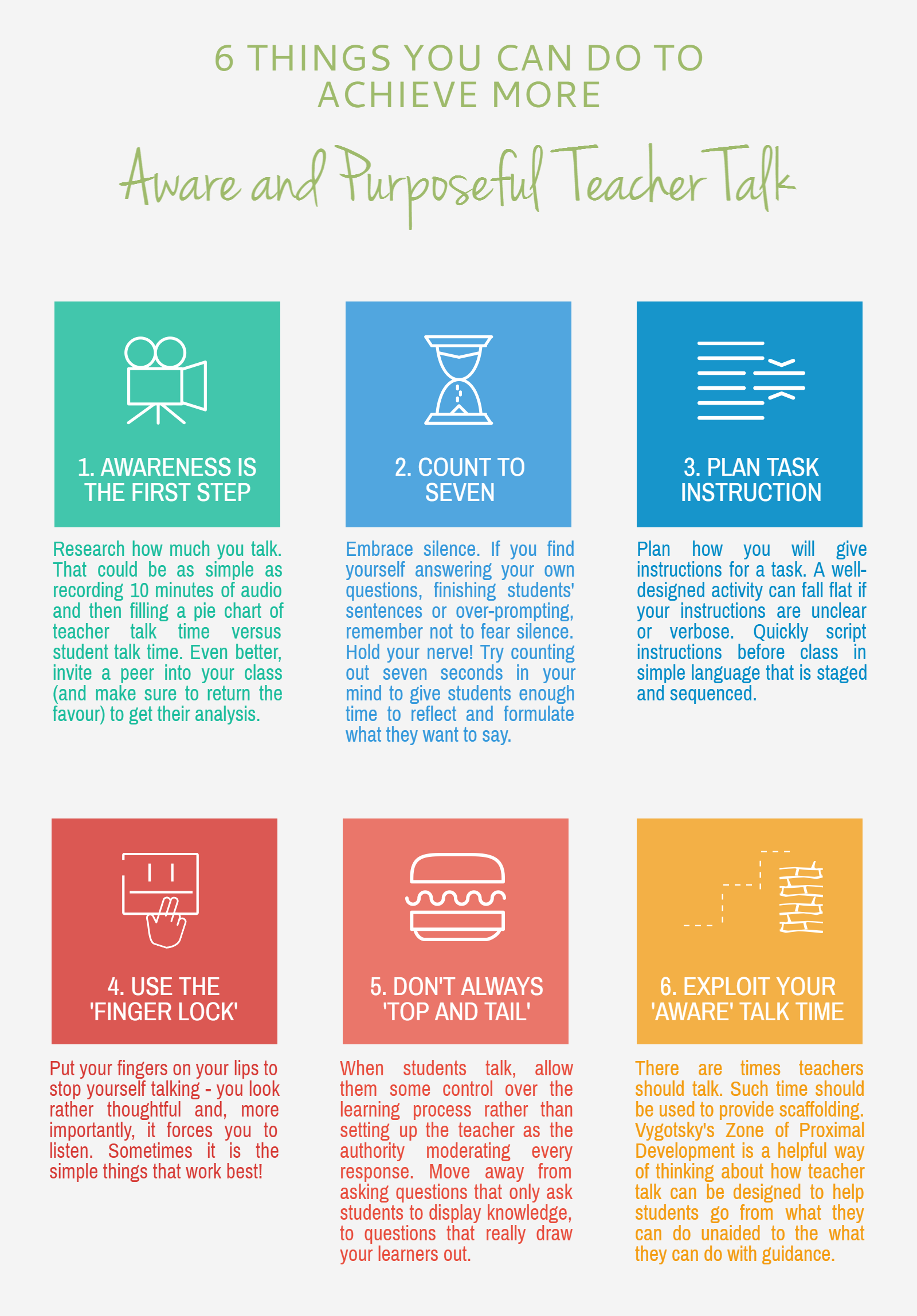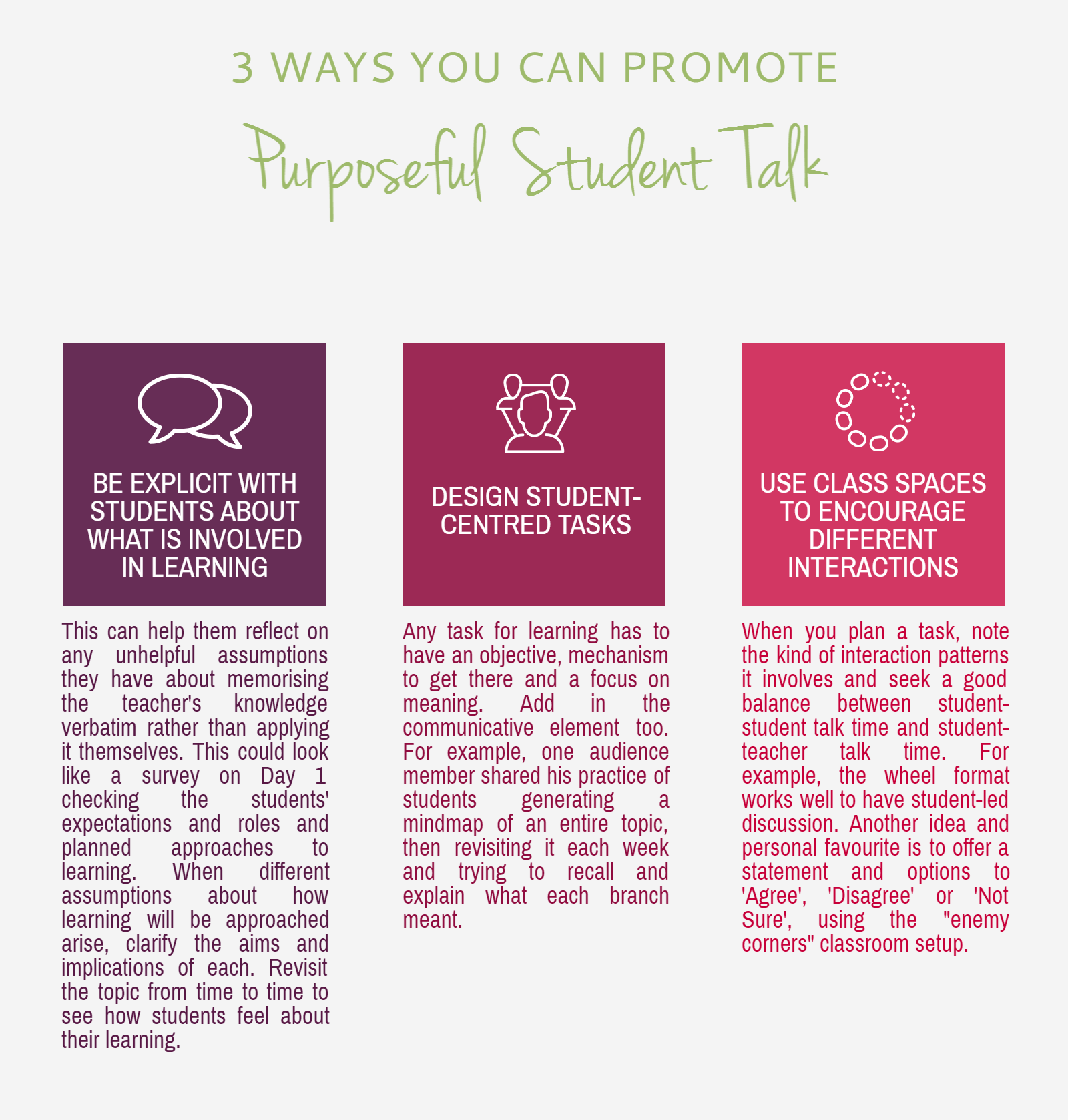Tackling teacher talk time [Infographic]

Our teacher talk may tell us something of our beliefs about teaching and learning. Is the learner seen as an ‘empty vessel’ to be filled with knowledge, for example? In that model of teaching and learning, teacher talk time is likely to be high, with the consequence that students may disengage from learning.
Students’ expectations and beliefs about learning can also make it easy for teachers to fall into the trap of talking too much. Believing that learning entails listening to the teacher in order to absorb knowledge or deference towards a teachers’ authority can predispose students to a passive approach to learning.
To kick off a recent presentation on this topic, I asked my audience to read a statement. Think about whether you agree or disagree.
Statement 1: “Teacher talk is essential for explanations of tasks/content.”
After a few moments, I asked people to share their thoughts. There were a range of responses and the conclusion we came to was that some teacher talk was unnecessary, but other forms of teacher talk were actually necessary, and that knowing the difference was important.
From Unaware Teacher Talk to Aware and Purposeful
Unaware teacher talk is talk that has not been considered or consciously designed. At such times, learners are likely to disengage and become bored, pulling out their smartphones or gazing out the window.
On the flip side, teacher talk can be effective if it is done with both awareness and purpose, especially when it comes to ‘scaffolding’ to foster the learner. So the goalposts for reducing talk time are not just around talking less but exploring how to engage learners. In the infographic below there are a number of strategies outlined that you may be able to adopt in your classroom, from focusing on the scaffolding that helps students reach beyond what they already know, to providing good instruction, student-centred tasks and more cooperative models of learning.

Planning for Purposeful Student Talk
We need language to process information. While students move towards realising their own potential with their teacher’s guidance, they also need to speak!
The world in language is half someone else’s. It becomes one’s own when the speaker populates it with his own intentions, his own accent, when he appropriates the word, adapting it to his own semantic and expressive intention.
– Bakhtin (1981)
How do we get purposeful student talk?
If you are interested in learning more about interaction patterns, including what interactions are encouraged by different designs and when you might try them, you can read about them in:
- Scrivener, J. (2011) Learning teaching, Third edition, Macmillan, Oxford, UK.
- Scrivener, J. (2012) Classroom management techniques, CUP, Cambridge, UK.
References and suggested readings:
- Fisher, D., Frey, N., Rothenburg, C. (2008) Content-area conversations: how to plan discussion based lessons, ASCD.
- Lee, J. (2000) Tasks and Communicating in Language Classrooms, McGraw-Hill, New York.
- Van Lier, L. (2001) Constraints and resources in classroom talk: issues of equality and symmetry, in Candlin, C. & Mercer, N. (eds), English language teaching in its social context, Routledge, London & New York.
- Vygotsky’s social learning theory: https://learning-theories.com/vygotskys-social-learning-theory.html
- For structuring your task explanation, the IDIOM acronym is handy. It was mentioned during my presentation by a colleague, Clare McGrath who also shared a resource on IDIOM in Yammer. Here’s the summary:
- I – Introduction. Provide context, aim, links to previous and following stages, and tell the students what the task is and how they will do it. Signal to the students if you’re going to do an example for them.
- D – Demonstrate. Walk the students through any examples given, or do an example with them (not for them) or have two students do an example for the others. You may need to give out materials here to all or some students or show the task on the screen.
- I – Interaction. Make it clear if the task is to be done alone, or in pairs, or in groups, or in teams; make it clear who is working with whom.
- O – Other. Provide that extra detail. For example, set the time limit.
- M – Materials. Give out the materials or ask students to access them. Say ‘Start’ or something similar.

